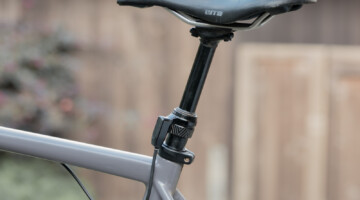Brands are always looking for ways to target a growing an audience, and “gravel” wheels were one of the hottest market segments at the trade shows last year. But it got me thinking about whether I know anyone who is going out to buy a high-end race wheelset just for gravel? I couldn’t think of a single person. I know plenty of people who do gravel races, but often it’s mostly to ride with friends and finish, and more often than not, done so using the same wheels (typically tubeless) used in training.
When I first saw the 29” Gravel wheelset by Knight Composites a year ago at Sea Otter, it certainly caught my attention for two reasons. First, it checked all the boxes in terms of what I usually look for in my own “race” wheelsets nowadays, with a light rim (355g), wide internal width (22.5mm), tubeless tire-securing profile and configurable axle options.
Second, because it was aimed directly at the gravel market, it seemed like Knight Composites was pigeonholing its product in a narrow market segment when cyclocrossers, mountain bikers and some disc-brake equipped roadies might appreciate the same product.
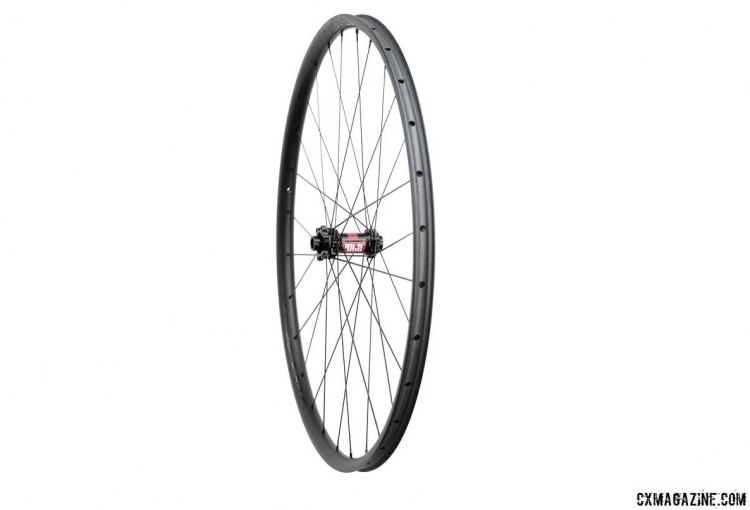
Knight Composites 29 Race / Gravel carbon tubeless disc wheelset features a low-profile rim and high-profile features. © Cyclocross Magazine
When our test set arrived late in the fall, gravel season was done but cyclocross racing was here. So naturally I grabbed two tubeless cyclocross tires and set off to see how gravel wheels might do with tubeless cyclocross racing. It’s not like the young company isn’t familiar with cyclocross. After all, the company provides tubular racing wheels for 13-time National Champion Katie Compton. Might they also help a heavier, slower and less-graceful rider find racing success?
Out of the Box
Knight Composites offers wheel configuration menus that allow the customer to choose from a selection of hubs, freehubs, decal colors and rotor attachment style. Our test wheel set was built around DT Swiss 240s six-bolt disc brake hubs. Twenty eight Sapim CX Ray spokes, in straight-pull format, keep the components laced together, secured by Pillar Hex 10 alloy nipples.
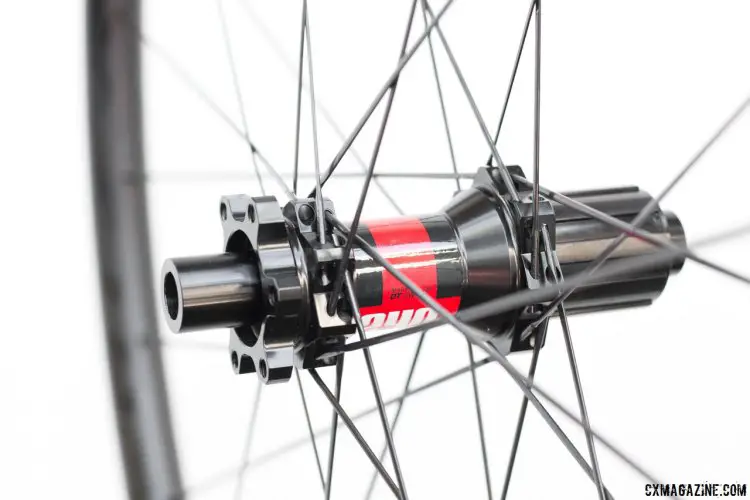
The 240s hubs offer different axle configurations with swappable caps, and customers can pick from Centerlock and 6-bolt rotor mounts and Shimano/SRAM or XD drivers. Knight Composites 29 Race / Gravel carbon tubeless disc wheelset. © Cyclocross Magazine
The Knight 29 gravel rim is just 25mm deep, 22.5mm wide (internal) and is said to weigh just 355g each. Most of the test wheels we’ve been riding lately have been 38mm or deeper, which makes such a shallow section rim look quite minimalist.
While many wheel companies grab off-the-shelf molded rims for their builds, Knight Composites claims proprietary technology and features differentiate its rims from much of the competition, citing the way it drills its rims as one key differentiator. Each rim is drilled for a certain lacing pattern, with the nipple hole angled at the flange in the exact angle the spoke will take from the hub flange to the rim. The company claims this precise drilling, compared to standard rims that just have spoke nipple holes pointed directly at the hub’s axle, allows it to use more affordable J-bend spokes over the more pricey straight pull versions, without a compromise in strength or durability. While Compton’s wheels and show wheels we saw last year featured J-bend spokes, our 29 Gravel test wheels featured straight-pull spokes.
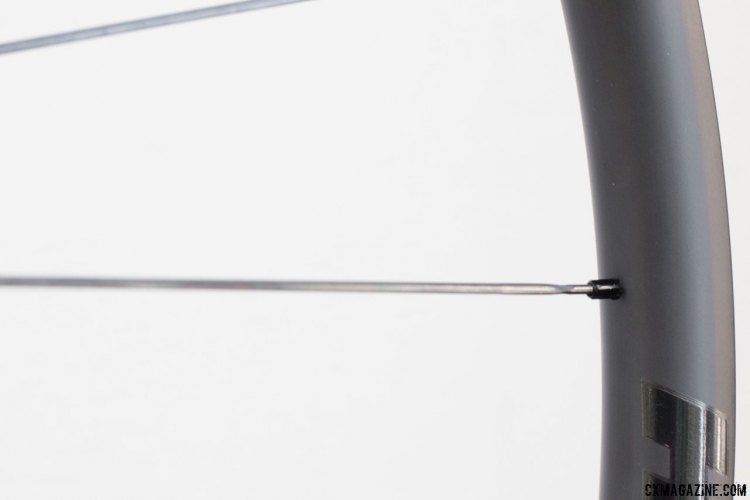
Knight Composites says it has reduced the stress at the nipple with precisely angled nipple hole drillings. 29 Race / Gravel carbon tubeless disc wheelset. © Cyclocross Magazine
While the spoke angle drilling is hard to notice when the wheel is laced up, other features are easily noticeable. The rim doesn’t have a prominent bead hook, has a moderately deep center channel, and offers up a flat shoulder with a small bead lip to keep the seated tire in place. Its subtle—far less pronounced than “barbs” seen on rims from American Classic—but noticeable.

Knight Composites 29 Race / Gravel carbon tubeless disc wheelset is 22.5mm wide (internal) and features a small lip to hold the tire’s bead in place. © Cyclocross Magazine
The rims come with tubeless valves. The valves are light, alloy, and come with washers that provide a nice, tight fit to the outer rim shape.
Our test wheels weighed 1380g per pair set up for 15mm front and 142/12mm rear. That’s a bit more than the 1325g list weight (although weights can vary based on axle and rotor mount configurations).
Installation Is a Snap, Patience Is Your Friend
Tire installation on the Knight Composites wheels thankfully wasn’t very memorable. Installing moderately tight Clement BOS (33c) and Ritchey Megabite (38c) tubeless tires was a one-lever ordeal, without cussing or bloody knuckles. An Islabikes Greim tubeless tire was even easier. With a compressor pump, all three tires snapped into place, but without the loud pop that you hear with some setups (that leaves you wondering if you’ve broken a bead or rim).
Sometimes easy installation equates to easy burping, and initially that seemed to be the case with these wheels. I could finger burp both tires after seating them with sealant, and was still able to do so after a few shakedown rides. You can see a bit of white sealant leak out below:
Such results indicate that the Knight Composites 29 rim is certainly not in the category of the slightly-oversized diameter rims like those from NoTubes or Alchemist, for better or for worse. Tire installation and removal is easier, tight tires like WTB’s TCS models actually fit, but setup with most tires is trickier and tire choice matters more.
Although the combinations (not specifically the rims or tires themselves) failed our initial finger-based tubeless reliability test, in real world riding, the setup was surprisingly just fine during the tail end of a surprisingly wet (i.e. low pressure, around 20 psi) cyclocross season. When not racing, I attempted to ride up and down stairs, on rocky doubletrack and technical singletrack, and did not experience any noticeable burping or pressure loss.
When paired with the looser fitting, more supple Islabikes Greim tire, getting an airtight setup took more time. Eventually the tire, thanks to the sealant and a handful of rounds of inflation, sealed up well and remained locked in place, but it certainly wasn’t a combination that I would feel confident switching to a day or two before a race.
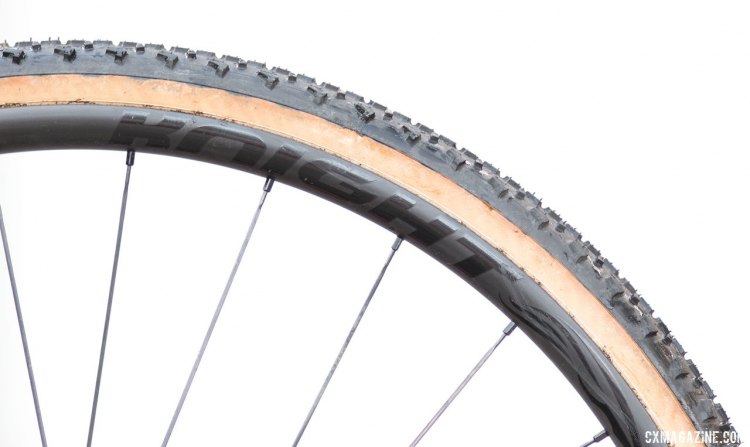
Looks like a lightweight tubular wheelset, but the Knight Composites 29 Race / Gravel carbon tubeless disc wheelset paired with Islabikes’ Greim Pro tire offers similar gram savings and suppleness without the ride-ending flat tire risk. © Cyclocross Magazine
Does a few days needed for a tire to cure before it’s safe to ride sound familiar? For some of us, that’s one big reason to avoid tubulars and opt for tubeless, but this tire and rim combination is proof once again that a proven or tested tire/rim choice is critical before trusting it to add to your Crossresults points haul.
Fatter tubeless tires are easier to set up to be burp-free from the start. The bigger volume of a 40c or larger (mountain bike) tire on the 22.5mm rim makes it much harder to push the bead away from the rim’s sidewall, and is more likely to have you ready to roll from the start. Suddenly, the gravel targeting of the rim rings true and starts to make sense.
Doing the Rounds
On your first ride, especially if these wheels are replacing a stock OEM wheelset, you can’t help but first notice the weight savings, particularly every time you pick up the bike. By shedding OEM wheels and perhaps some heavy 35c inner tubes, you can easily shed a pound or more off your bike. That is certainly noticeable whether it’s at the barriers, run-up or even sprinting out of a hairpin corner.
The 22.5mm internal width also adds a good amount of volume to any cyclocross tire. A general loose rule of thumb is each mm of added rim width adds about a third of a mm to tire volume, so if you’re coming from a 17mm wide rim, you can expect the same tire on the Knight 29 Race wheels to be about 2mm wider. That extra volume helps add a bit more cushion and traction, and allows you to ride a bit lower pressure. That’s almost always a good thing on a bumpy or slippery course cyclocross, unless you’re hoping to stay within UCI or Nationals tire width limits or really limited in tire clearance.
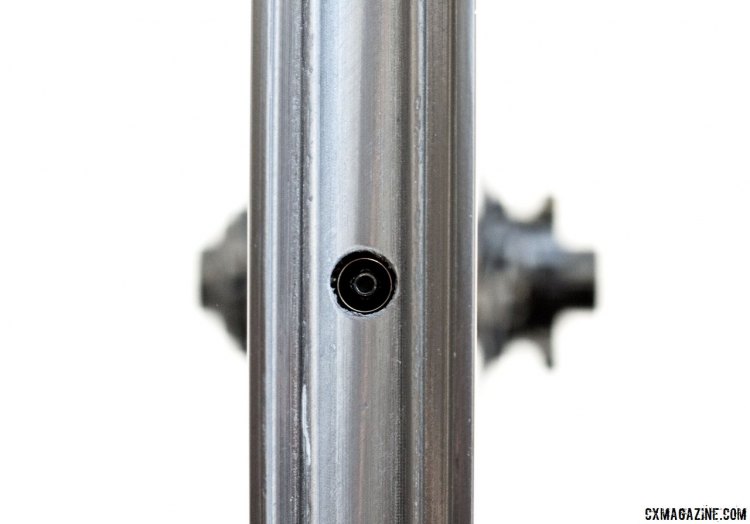
Knight Composites 29 Race / Gravel carbon tubeless disc wheelset features precisely-drilled nipple holes, and a small lip to hold the tire’s bead in place. © Cyclocross Magazine
At Sea Otter, Knight Composites said this rim will handle 55psi for any tire width. That pressure limit probably eliminates using these wheels as a road wheelset unless you’ve got clearance for fat rubber run at 55psi or less. However, most racers inclined to hit the pavement in the offseason probably will want a deeper section rim for dirt and pavement dual duty for better aerodynamics. The 35 Disc offered by Knight might better suit such needs, as well as other deeper section wheels like the Atomik 38 Disc wheels we’re also testing.
Despite some worrisome initial tire setup, the Knight Composites 29 Gravel wheelset has been a great lightweight option for both cyclocross racing and everyday mixed terrain riding, including gravel. They’ve remained straight, true and round, and the bearings are still smooth. The weight savings alone has kept me moving them between a few bikes—especially when riding 26-pound adventure bikes have felt heavy on the legs.
Knight Composites talks a lot about compliance and comfort, but because I rode these wheels with low pressure cyclocross tires, I can’t say I noticed any particular benefit. Pump a big tire up to 55psi and you might be able to tell if there’s some compliance benefits, but my experience has been that vertical compliance of a rim (not lateral stiffness) is most noticeable with narrow, high pressure road tires. At just 25mm deep, the rims certainly look like they’d be more comfortable than a 35mm or deeper section rim, but I’d be lying if I said they offer a magic carpet ride and I believe tires and air pressure will make a much bigger difference in cyclocross or gravel.
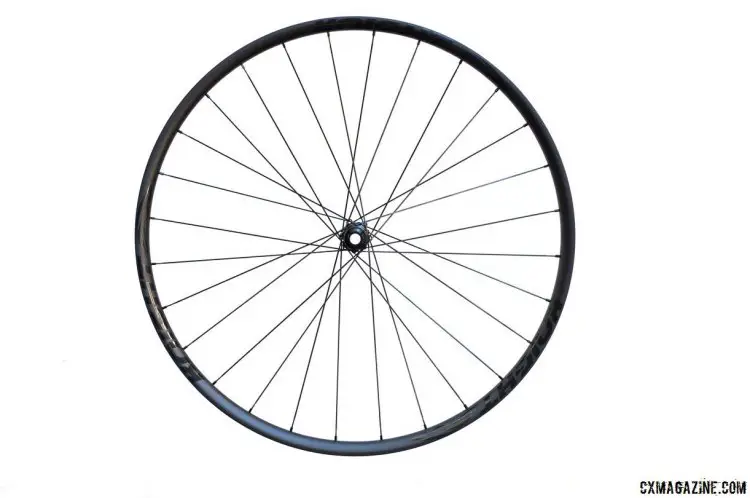
Knight Composites 29 Race / Gravel carbon tubeless disc wheelset swaps between different axle configurations easily. 28 Sapim CX-Ray spokes front and rear. © Cyclocross Magazine
While the test wheels have gone through almost everything (with the exception of an actual gravel race) with success, the promising results made me think Knight Composites might be missing the mark with its gravel label. Racers spending $2199 on wheels just for gravel seems like a rare breed while cyclocross racers and cross country mountain bikers (and cyclists who tackle all such riding) could be equally attracted to such a build.
The funny thing is, between receiving the wheels and writing up my initial experience, it seems Knight and its athletes came to the same conclusion. The UCI OMX mountain bike team eyed the wheels, had success using them, and convinced the company they were also worthy for fat tire racing. And thus the 29 Gravel wheel was renamed to the 29 Race and now sits in both the company’s cyclocross/gravel and mountain bike lineups.
The Verdict
Just as in life, there are compromises with any product. The Knight Composites 29 Race tubeless carbon wheels are pricey at $2199, aren’t particularly aero, have a pretty low pressure restriction, and don’t offer the tightest fit for some cyclocross-width tires.
Still, the wheels have an impressive build quality, features that reflect attention to detail with an eye towards durability, and an undeniable weight savings over all but the most expensive stock wheelsets.
The price tag might cause indigestion for some, but if they’ll get year ‘round use on a few bikes, perhaps the math is easier to swallow. In three months, despite some initial tire setup hiccups, they’ve been burp free in riding.
Are they right for you?
Hopefully these initial impressions have given you enough to chew on.
See the full photo gallery below the specs.
Knight 29 Race / Gravel Wheel Specs:
MSRP: $2199 as built, up to $2399 with hub upgrades
Rim: 25mm deep, 22.5mm wide (internal) carbon tubeless, 28h, 55 psi maximum
Spokes: 28 Sapim CX-Ray front and rear, straight pull on our test wheels with Pillar Hex 10 nipples
Hubs: DT Swiss 240s, for 15mm thru axle front, 142/12mm thru axle rear
Warranty: 5 years, plus crash replacement option
More info: knightcomposites.com
Knight 29 Race / Gravel Wheel Photo Gallery:


























